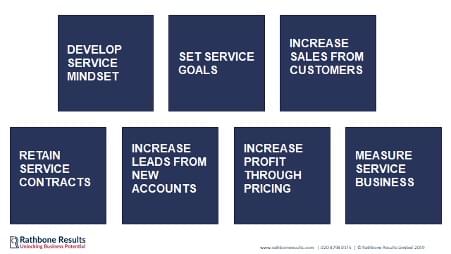30 second summary:
Many businesses face a common challenge, ‘how can we increase profits sustainably?’…
Unsurprisingly, pricing is a major factor. From developing the right mindset to differentiating pricing based on service offering, contract size and market sector, this article highlights key ways to increase profits through pricing.
There are three primary ways to increase the profitability of your company, you can either sell more, reduce costs and/or price higher.
So, how can profitability be improved through pricing, even during challenging times?
1. Develop the right mindset
Businesses often underestimate just how much effective pricing management can impact on profitability. Yet so many companies worry about increasing prices due to the fear of losing the business and some companies do not buy on price. The widespread belief that everybody is looking for the cheapest version of everything is simply not true. If this were the case, everybody would live in the cheapest houses, drive the cheapest cars, wear the cheapest clothes, and have the cheapest holidays.
The real reason that prospective customers do not buy from you is probably not primarily related to your prices. Are you giving a high-enough level of customer service? Have you given the prospect a clear understanding of the benefits they will experience when they do business with you? Have you given a compelling reason for buying from you versus the competition?
There is another reason to do everything possible to avoid lowering your prices. Even if it increases your sales now, have you increased your overall margin? Lowering prices will also make it very difficult for you to charge the prices that you deserve in the future.
2. Differentiating pricing and manage a pricing policy
Differentiate your pricing based on your service offering, contract size and market sector. By way of example from the security sector:
There are very different sensitivities to price increases on annual service contract renewals for the following types of customers:
- Residential customers who have a “bell only” burglar alarm system. This customer type may react if the contract price has gone up by a few pounds. The invoice is often scrutinised by the homeowner before payment.
- Residential customers who have a monitored burglar alarm system which allows police response. This customer type is less price-sensitive than the previous category since they are already investing in a monitoring service to provide adequate protection to their home.
- Commercial customers where the intruder alarm system protects the property and company assets. Not all businesses will compare the prices with the previous year. The contract value can represent a small figure against the total annual expenditure of the company.
Many companies apply the same price increase to all contracts without considering the different customer types and the different value those customers place on the services.
Price differentiation can occur in several different areas of call-out services. For example:
- Direct customer versus an intermediary (e.g. a facility management customer).
- Commercial versus the residential customer.
- Contract customer versus non-contract customer.
- Out-of-hours versus normal hours (9 am till 5.30 pm on a weekday).
- Emergency response.
- Distance travelled, e.g. where the call-out requires more than one hour of travel.
- The complexity of system e.g. where a higher grade of service engineer is required.
Enforce the discipline of recording both starts and finish times for engineers on callouts, so that onsite time starts when the engineer has parked his car and finishes when the engineer arrives back at his car.
Pricing has such a major impact on business profit that it is worthwhile applying more management focus in this area. A small improvement can make a significant difference.
From experience and studies on pricing, most businesses can improve their net profit by at least 2 to 3 percentage points by using effective price management and differentiation. For a company with sales of £2m, this can mean an additional £40-60k net profit. For some installers, the upside can be much higher. One client increased their gross profit by more than 10 percentage points over the last 12 months through changes to the cost build-up and pricing policies.
3. Test and measure price increases
The only person who knows whether you are charging the right price is your customer. Don’t let fear be the reason why you keep prices as they are or even reduce them.
Test price increases. You do not have to make big bets in pricing. You can conduct controlled tests on a sample of your customers, measure the results and then decide on the next steps. Measure the conversion rates before and after the price increase.
For example, test increasing prices on service or small works. Benchmark your quote to order conversion rates – which should be 50% or more - before and after price increases. Gross profit % should be significantly higher in service and small works than in new installation projects.
4. Structure the approach to service contract pricing
Use a service contract price calculator to provide a structured and uniform method of calculating service contract prices. This will include standard times for servicing different products and build in costs for the following e.g.
- Full recovery of hourly labour cost.
- Travel time.
- Working at height.
- Two men are needed for health and safety reasons.
- Out-of-hours work.
- Equipment hire charges, e.g. cherry pickers or mobile platforms.
It is vital to build in these costs, especially when pricing larger service contracts.
Effective management of service pricing is a significant contributor to profitability. Aim for 50% gross margins for service contracts, call-outs, and small works in the knowledge that this is being delivered by sustainable businesses in our sector.
Know that you can achieve this by developing the right mindset to pricing, through differentiated pricing, by testing and measuring price increases and by developing a more structured approach to pricing. Profitability will improve even during challenging times.

Book an exploratory call to find out how we can help you unlock your business potential.
Don't miss our latest insights
Subscribe to our Resource centre
Other articles that may interest you:

How Do I Develop a Business Mindset?
Most time and energy is invested in designing, quoting, project managing, installing and getting paid for the installed system. Yet most of the pro...
Read more
How Do I Know Which Lead Generation Method Will Work?
Most owner managed businesses have only one marketing method to reach new customers. For many, this is usually word of mouth or the use of direct ...
Read more